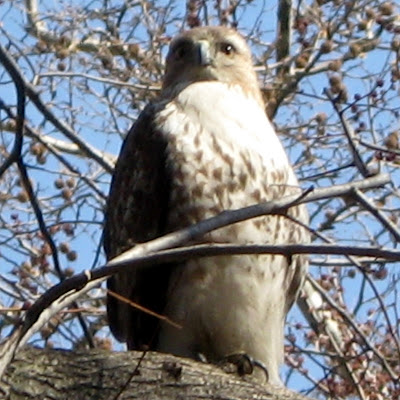    | I, (sookietex) the creator of this work, hereby release it into the public domain. This applies worldwide. In case this is not legally possible, I grant any entity the right to use this work for any purpose, without any conditions, unless such conditions are required by law. If This image is subject to copyright in your jurisdiction, i (sookietex) the copyright holder have irrevocably released all rights to it, allowing it to be freely reproduced, distributed, transmitted, used, modified, built upon, or otherwise exploited in any way by anyone for any purpose, commercial or non-commercial, with or without attribution of the author, as if in the public domain. Red-tailed Hawk From Wikipedia, the free encyclopedia The Red-tailed Hawk (Buteo jamaicensis) is a medium-sized bird of prey, one of three species colloquially known in the United States as the "chickenhawk." It breeds almost throughout North America from western Alaska and northern Canada to as far south as Panama and the West Indies, and is one of the most common buteos in North America. There are fourteen recognized subspecies, which vary in appearance and range. It is one of the largest members of the genus Buteo in North America, weighing from 690 to 2000 grams (1.5 to 4.4 pounds) and measuring 45–65 cm (18 to 26 in) in length, with a wingspan from 110 to 145 cm (43 to 57 in). The Red-tailed Hawk displays sexual dimorphism in size, as females are 25% larger than males. Red-tailed Hawk plumage can be variable, depending on the subspecies. These color variations are called morphs, and a Red-tailed Hawk may be light, dark, or rufous. The Red-tailed Hawk is successful in large part because it tolerates a wide range of habitats and altitudes, including deserts, grasslands, coniferous and deciduous forests, tropical rainforests, agricultural fields and urban areas. It lives throughout the North American continent, except in areas of unbroken forest or the high arctic.It is also legally protected in Canada, Mexico and the U.S. by the Migratory Bird Treaty Act of 1918. Approximately 60% of all raptors under 1 year of age taken from the wild for use in American falconry are Red-tailed Hawks. The Red-tailed Hawk also has significance in Native American culture. |
A male Red-tailed Hawk may weigh from 690 to 1300 grams (1.5 to 2.9 pounds) and measure 45–56 cm (18 to 22 in), while a female can weigh between 900 and 2000 grams (2 and 4.4 pounds) and measure 50–65 cm (20 to 26 in) in length. As is the case with many raptors the Red-tailed Hawk displays sexual dimorphism in size, as females are 25% larger than males. The wingspan is from 110 to 145 cm (43 to 57 in).
Red-tailed Hawk plumage can be variable, depending on the subspecies and the region. These color variations are morphs, and are not related to molting.
The western North American population, B. j. calurus, is the most variable subspecies and has three color morphs: light, dark, and intermediate or rufous. The dark and intermediate morphs constitute 10–20% of the population.
Though the markings and hue vary, the basic appearance of the Red-tailed Hawk is consistent. The underbelly is lighter than the back and a dark brown band across the belly, formed by vertical streaks in feather patterning, is present in most color variations. The red tail, which gives this species its name, is uniformly brick-red above and pink below. The bill is short and dark, in the hooked shape characteristic of raptors. The cere, the legs, and the feet of the Red-tailed Hawk are all yellow.
Immature birds can be readily identified at close range by their yellowish irises. As the bird attains full maturity over the course of 3–4 years, the iris slowly darkens into a reddish-brown hue. In both the light and dark morphs, the tail of the immature Red-tailed Hawk are patterned with numerous darker bars.
This article is licensed under the GNU Free Documentation License. It uses material from the Wikipedia article, Hummer SEE FULL License, Credit and Disclaimer
Tags: Public Domain Clip Art and clip art or public domain and Red-tailed Hawk or bird of prey













No comments:
Post a Comment